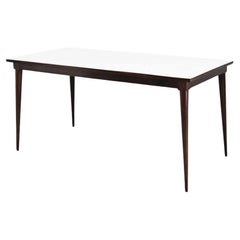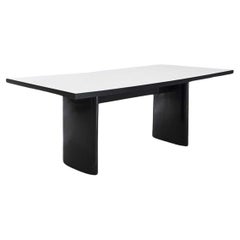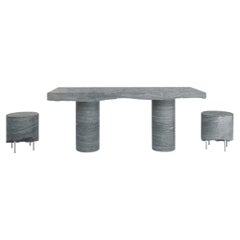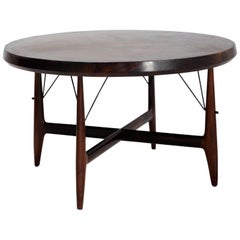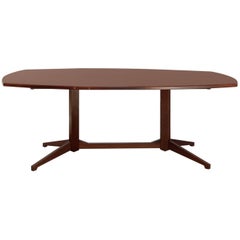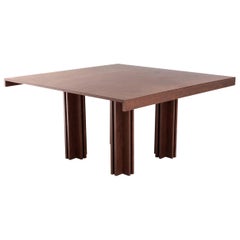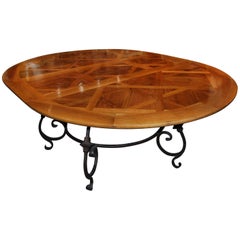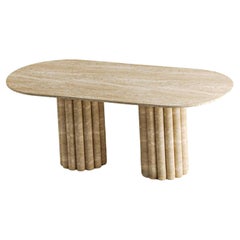Side-Gallery Dining Room Tables
to
Height
to
Width
to
Depth
to
7
5
2
2
5
2
4
1
2
1
5
3
3
2
2
4
3
3
2
1
7
7
7
1
1
1
1
1
Geraldo de Barros Dining table, 1955
By Geraldo de Barros
Located in Barcelona, ES
Dining table
Manufactured by Unilabor Brasil, 1955 Jacaranda, white formica top
110cmx53cmx75hcm
43,31 in x 20,83 in x 29,75h in
Provenance
Private collection, Sao Paulo
Category
Vintage 1950s Brazilian Dining Room Tables
Materials
Formica, Jacaranda
Dining table by Joaquim Tenreiro, 1950
By Joaquim Tenreiro
Located in Barcelona, ES
Important dining table
Manufactured by Tenreiro Moveis e Decoraçoes
Brazil, 1950
Solid jacaranda ebonized wood and white lacquered formica top
Measurements
223 cm x 98 cm x 74h cm
87,69 in x 38,58 in x 29,13h in
Literature
Joaquim Tenreiro, by Soraia Cals and Maria Cecilia Loschiavo dos Santos...
Category
Vintage 1950s Brazilian Dining Room Tables
Materials
Formica, Jacaranda
Contemporary Dark Grey Marble Dining Table "Concept Kitchen" by Sam Chermayeff
By Sam Chermayeff
Located in Barcelona, ES
Sam Chermayeff
Table
From the series “Concept Kitchen”
Produced in exclusive for SIDE GALLERY
Manufactured by Bagnara
Italy, 2020
Pannonia Grün marble
Contemporary Design
M...
Category
21st Century and Contemporary German Dining Room Tables
Materials
Marble
Sergio Rodrigues Round Wooden Dining Table "Stella" Oca mid-century Brazil 1956
By Oca, Sergio Rodrigues
Located in Barcelona, ES
Sergio Rodrigues (1927-2014)
Round dining table model “Stella”
Manufactured by Oca
Brazil, 1956
Jacaranda wood, brass, iron
Measurements
122 cm diameter x 73 height cm
48 in diamet...
Category
Mid-20th Century Brazilian Mid-Century Modern Dining Room Tables
Materials
Brass, Iron
Franco Albini Mahogany mid-centry Italian Table Model TL-22 produced by Poggi
By Franco Albini
Located in Barcelona, ES
Franco Albini & Franca Helg.
Dining table model no. TL22.
Manufactured by Poggi,
Italy, 1958.
Mahogany.
Measurements:
180.3 cm x 104.1 cm x 73 H cm.
70.98 in x 40.98 in x 28.74 in.
Literature:
Giuliana Gramigna, Repertorio 1950/1980, Milan, 1985, p. 123.
Franco Albini, was born in 1905 and died in 1977. He spent his childhood and part of his youth in Robbiate in Brianza, where he was born. Albini, as an adolescent moved with his family to Milan. Here he enrolled in the Faculty of Architecture of the Polytechnic and graduated in 1929. He started his professional activity in the studio of Gio Ponti and Emilio Lancia, with whom he collaborated for three years. At the 1929 International Exhibition in Barcelona (where Gio Ponti curated the Italian pavilion and Mies van der Rohe realized that of Germany) and in Paris where, as Franca Helg recounted, he had the opportunity to visit the studio by Le Corbusier.
In those three years, the works he carried out are admittedly of the twentieth century imprint. It is the meeting with Edoardo Persico that marked a clear turning point towards rationalism and the approach to the group of editors of "Casabella". The partly ironic and partly very harsh comments of the Neapolitan critic to a series of drawings, made by Albini for the design of some office furniture, caused him a great disturbance. “I spent days of real anguish - Albini recalls - I had to answer all the questions. I also had a fever, a large and long fever. "
The meted provoked Albini to openen a professional studio in via Panizza with Renato Camus and Giancarlo Palanti. The group of architects began to deal with public housing by participating in the competition for the Baracca district in San Siro in 1932 and then building the IFACP neighborhoods: Fabio Filzi (1936/38), Gabriele D'Annunzio and Ettore Ponti (1939).
During this period, Albini also worked on his first villa (Pestarini), which Giuseppe Pagano, architect and critic of the time, presented as follows: “This coherence, which the superficial rhetoric of fashionable jugglers calls intransigence, and which is instead the basis of understood between the fantasy of art and the reality of the craft, in Franco Albini, it is so rooted that it transforms theory into a moral attitude ".
But it is above all in the context of the exhibitions that the Milanese master experienced his compromise between that "rigor and poetic fantasy" of which Pagano speaks, coining the elements that became a recurring theme in his . The opening in 1933 of the new Triennale headquarters in Milan, in the Palazzo dell'Arte, was an important opportunity to express the strong innovative character of rationalist thinking, a gym in which to freely experiment with new materials and new solutions, but above all a "method". "Cultivated as a communication laboratory, the art of setting up was for the rationalists of the first generation what the perspective had been for the architects of humanism: the field open to a hypothesis of space that needed profound reflections before landing the concreteness of the construction site ".
Together with Giancarlo Palanti, Albini on the occasion of the V Triennale di Milano set up the steel structure house (with R. Camus, G. Mazzoleni, G. Minoletti and with the coordination of G. Pagano), for which he also designed the 'furniture. At the following Triennale of 1936, Persico dided, together with a group of young designers gathered by Pagano in the previous edition of 1933, Franco Albini took care of the preparations of the home exhibition. The setting up of Stanza per un uomo, at that same Triennale, allows us to understand the acute and ironic approach of Albini, as a man and as a designer: "Celebrating the beauty of mechanics was the imperative to which, for example, the surprising displays by Franco Albini who managed, in the subtle way of a refined and rarefied style, to sublimate their practical content in the metaphysics of daring still lifes: flying objects which marked in the void refined frames and metal intricacies the nodes of a fantastic cartography where industry finally became art free from purpose ".
That same year Albini and Romano designed the exhibition of the Ancient Italian Goldsmithery: vertical uprights, simple linear rods, designed the space. A theme, of the "flagpole", seemed to be the center of the evolution of production and the creative process. The concept is reworked over time, with the technique of decomposition and recomposition typical of Albinian design: in the preparation of the Scipione Exhibition and contemporary drawings (1941) the tapered flagpoles, on which the paintings and display cases were hung, are supported by a grid of steel cables; in the Vanzetti stand (1942) they take the V-shape; in the Olivetti shop in Paris (1956) the polished mahogany uprights support the shelves for the display of typewriters and calculators.
The flagpole is found, however, also in other areas. In the apartments he designed, it is used as a pivot on which the paintings can be suspended and rotated to allow different points of view, but at the same time as an element capable of dividing the spaces. The Veliero bookcase...
Category
Mid-20th Century Italian Mid-Century Modern Dining Room Tables
Materials
Mahogany
Carlo Scarpa, Small Dining Table Model “Quatour”, Walnut, Italy 1974
By Carlo Scarpa
Located in Barcelona, ES
Carlo Scarpa
Dining table model “Quatour”
Manufactured by Simon Gavina
Italy, 1974
Walnut wood
Measurements:
141 cm x 141 cm x 72 H cm
55.9 in x 55.9 in x 28 H in.
Litera...
Category
Vintage 1970s Italian Dining Room Tables
Materials
Walnut
Lukas Saint-Joigny, Contemporary Round Dining Table, 2020, Light Grey Resin
By Lukas Saint-Joigy
Located in Barcelona, ES
Lukas Saint-Joigny
Round Dining Table
From the “Ore” series
Manufactured by Lukas Saint-Joigny
Produced in exclusive for SIDE GALLERY
Paris, 2020
Various materials and polyuret...
Category
21st Century and Contemporary French Dining Room Tables
Materials
Resin
Related Items
Fabulous Parquet de Versailles Oval Dining Table
Located in New Orleans, LA
This table is made up of 18th century parquet flooring with an iron base.
Category
21st Century and Contemporary French Dining Room Tables
Italian Travertine Marble Dining Table - Personalized Marble Kitchen Table
Located in İnegöl, TR
TRAVERTINE MARBLE TABLE
Type of Marble: Travertine
Dimensions: 75" x 35" (190 x 90 cm)
Leg Model: Travertine
Customizable: Available!
Production Time: 3-4 Weeks
Shipping Cost: Free!...
Category
2010s Turkish Arts and Crafts Dining Room Tables
Materials
Travertine, Marble
$4,990
H 29 in W 35 in D 75 in
Silver Travertine Marble Dining Table - Stone Kitchen Table - Custom Marble
Located in İnegöl, TR
SILVER TRAVERTINE MARBLE OVAL DINING TABLE
Type of Marble: Silver Travertine
Dimensions: 75" x 35" (190 x 90 cm)
Leg Model: Travertine
Customizable: Available!
Production Time: 3-4 ...
Category
2010s Turkish Arts and Crafts Dining Room Tables
Materials
Travertine, Marble
$5,600
H 29 in W 35 in D 75 in
Onyx Marble Dining Table - Translucent Marble Dining Table - Marble Dining Table
Located in İnegöl, TR
ONYX MARBLE DINING TABLE
Type of Marble: Onyx
Dimensions: 80" x 40" (200 x 100 cm)
Customizable: Available!
Production Time: 3-4 Weeks
Shipping Cost: Free!
Package Method: Wooden P...
Category
2010s Turkish Organic Modern Dining Room Tables
Materials
Stone, Marble, Onyx
$8,900
H 29 in W 40 in D 80 in
"Orseolo" Black Table by Carlo Scarpa for Simon Gavina, Italy 70s
By Carlo Scarpa, Simon Gavina Editions
Located in Sacile, PN
Carlo Scarpa "Orseolo" black table for Simon, 1972.
Table, polyester varnished with mirror polished finish, made for the assembly of thick, elementary geometric panels with satin-fi...
Category
Vintage 1970s Italian Mid-Century Modern Dining Room Tables
Materials
Wood
$7,307
H 28.35 in W 94.49 in D 30.71 in
Large Black Lacquer Extending Dining Room Table by Maison Jansen, France 1955.
By Maison Jansen
Located in Brussels, BE
Elegant black lacquered extending dining room table (3 leaves) on casters with pull rings.
Minimal brass details. 3 leaves ( 60 cm -115 cm each)
In the style of Louis XVI, the table ...
Category
Mid-20th Century French Louis XVI Dining Room Tables
Materials
Brass
$6,241 Sale Price
20% Off
H 29.93 in W 108.27 in D 45.28 in
Solid Imbuia with Red Glass Top Dining Table by Joaquim Tenreiro, Brazil C. 1949
By Langbach & Tenreiro, Joaquim Tenreiro
Located in New York, NY
Restored.
Category
Vintage 1940s Brazilian Mid-Century Modern Dining Room Tables
Materials
Glass, Imbuia, Wood
$120,400
H 29.53 in W 86.62 in D 37.41 in
Carlo Scarpa Dining Table for Bernini, Italy, 70s
By Carlo Scarpa, Bernini
Located in Sacile, PN
Carlo Scarpa Dining Table for Bernini, Italy, 70s
This table is designed by Carlo Scarpa, a renowned Italian architect and designer. The table features a minimalist and elegant desi...
Category
Vintage 1970s Italian Mid-Century Modern Dining Room Tables
Materials
Wood
De Coene Art Deco Dining Table, 1941
By De Coene Frères
Located in Antwerp, BE
Dining table by De Coene Frères chairs, model Voltaire, featured in original catalogue as the number 03-81-689 (Source: Noël Hostens, De Coene A...
Category
Vintage 1950s Belgian Art Deco Dining Room Tables
Materials
Brass
Franco Albini TL22 wooden desk by Poggi Pavia, Italy, 1950s
By Poggi, Franco Albini
Located in Chiavari, Liguria
Desk with shaped top from the "TL 22" series, wooden structure, italian manufacture from the 1950s, crafted by Poggi and designed by Franco Albini.
This office desk stands out with ...
Category
Vintage 1950s Italian Mid-Century Modern Desks and Writing Tables
Materials
Wood
Danish Modern Sergio Rodrigues Brazilian Mesa Norma Rosewood Game Dining Table
By Sergio Rodrigues
Located in Wayne, NJ
Mid-Century Modern rosewood game table ' Mesa Norma ' with four inset drink holders and reversible top to felt, by Sergio Rodrigues. This Item may only be shipped within the USA .
Category
Vintage 1960s Brazilian Mid-Century Modern Game Tables
Materials
Rosewood
$4,800 Sale Price
20% Off
H 28 in W 36.5 in D 36.5 in
Sergio Rodrigues, Dining table "Ilidio", wood, c. 1960
By Sergio Rodrigues
Located in PARIS, FR
Model table 'Ilidio' created in 1965 by Sergio Rodrigues. This table presents itself as a summary of the style of Sergio Rodrigues, who made him "the most Brazilian designer". It is ...
Category
Mid-20th Century Brazilian Mid-Century Modern Dining Room Tables
Materials
Metal
